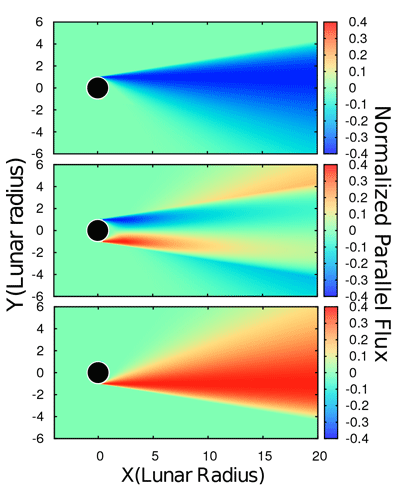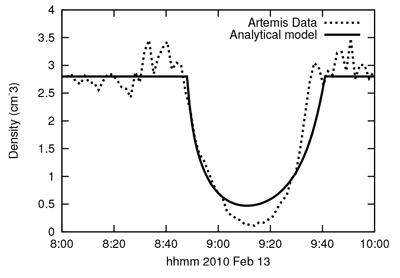2015 ARTEMIS SCIENCE NUGGETS
Analytic model of the lunar wake
H. Gharaee
University of Alberta, Edmonton
Introduction
Plasma coming from the Sun, the solar wind, impacts the Moon surface on the day side where it is absorbed and neutralized. Due to the supersonic flow of solar wind, there results a conical void or wake region downstream on the night side. The pressure difference between the solar wind across the wake boundary tends to drive plasma flow mainly along magnetic field lines, into the wake.
A new analytic model has been developed which describes field-aligned counter-streaming plasma flows in the lunar wake. The analytic approach rests on the assumptions that (i) the solar wind is strongly magnetized, (ii) plasma can be treated as a quasi-neutral isothermal fluid, (iii) the ion polarization drift can be neglected, and (iv) the magnetic field is constant and uniform everywhere in space.
Results
Results from the analytic model have been compared with results from a more complex hybrid simulation code. Comparisons have also been made with in situ ARTEMIS spacecraft observation.
| Figure 1. Normalized plasma parallel fluxes along the magnetic field are obtained in the analytic model. |
A result of this analytic model, which is not easily obtained from other more complex models, is an explicit expression for the ion flow velocity parallel to the magnetic field entering the wake from below, and from above the wake boundary. Figure 1 illustrates the normalized parallel ion fluxes Γ1,2 ∥ = (n1,2M1,2)/nsw0, where nsw0 is the upstream solar wind density and the parallel Mach number M∥, is the ratio of solar wind speed to the sound speed. The middle panel shows the approximate net normalized flux Γ = Γ1 ∥ + Γ2 ∥. The net ion parallel flow at the center of the wake (at y = 0) vanishes by symmetry, but the fact that it is associated with two counter-streaming flows would be missing in standard 2D or 3D fluid models.
| Figure 2. Comparison of ARTEMIS data (dotted line) and the analytic model ion density. |
Comparison Between Theory and Observations
We now consider a comparison between the density estimated analytically along the trajectory of the P1 spacecraft of the ARTEMIS mission during its first flyby through the lunar wake. In this flyby the satellite went through the wake at a distance of ~ 3.5RM from the Moon center downstream. This event occurred on 13 February 2010 between 08:53 and 09:29 UT. In this event the upstream plasma density was nsw = 3.14 cm-3, and the electron and ion temperatures were such that the sound speed was cs ~48.8km/s. Figure 2 shows both the analytically computed (solid) and measured densities (dots) as a function of time. The density obtained analytically is seen to be in good agreement with measured values. Quantitatively, the two densities agree within ≃8% almost everywhere, the exception being in a narrow range at the wake edge where the discrepancy does not exceed ≃25%. Qualitatively, the shapes of the wakes are similar. The depth of the wake from ARTEMIS data is ~3.9% of the background plasma density, while that obtained from the analytic model is higher ~16.2%.
Conclusion
In this paper we extended and made use of an analytic model of the lunar wake first proposed by [Hutchinson(2013)] to model the edge of the lunar wake. Ion density pro les obtained with this model were compared with those from a 2D hybrid model, and generally good agreement has been found. We also compared the results of the analytic model with data from an ARTEMIS P1 flyby. The good qualitative and quantitative agreement between the two indicates that despite its simplicity our analytic model is capable of capturing much of the physics at play in the formation of the lunar wake. The 2D analytic model presented here can also be used to estimate quantities that are not predicted by more complex models. An example is counter-streaming flows along the magnetic field associated with plasma entering from opposite (along ~B) edges of the wake boundary.
References
Hutchinson, I. (2013), Near-lunar proton velocity distribution explained by electrostatic acceleration, J. Geophys. Res., Space Phys., 118 (5), 1825-7.Gharaee, H., R. Rankin, R. Marchand and J. Paral (2015), Properties of the lunar wake predicted by analytic models and hybrid-kinetic simulations, J. Geophys. Res., Space Phys., 120.
Biographical Note
Hossna Gharaee is a graduate student in Space Physics at University of Alberta, under supervision of Professor Robert Rankin and Professor Richard Marchand. Her research includes the interaction between the Moon and solar wind and dust charging in the lunar environment.
 Please send comments/suggestions to
Emmanuel Masongsong / emasongsong @ igpp.ucla.edu
Please send comments/suggestions to
Emmanuel Masongsong / emasongsong @ igpp.ucla.edu

